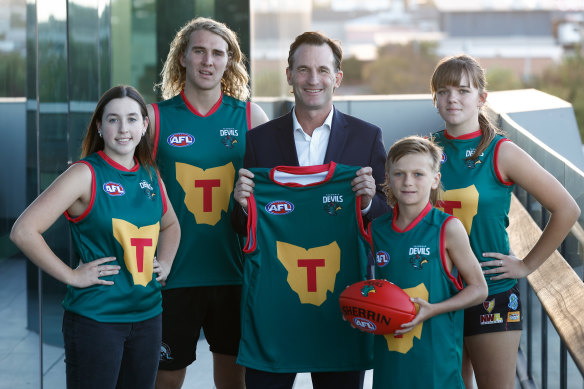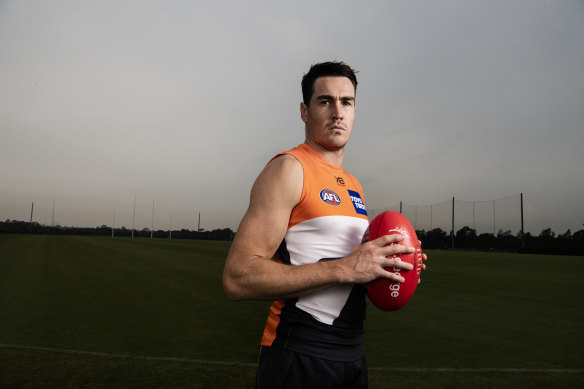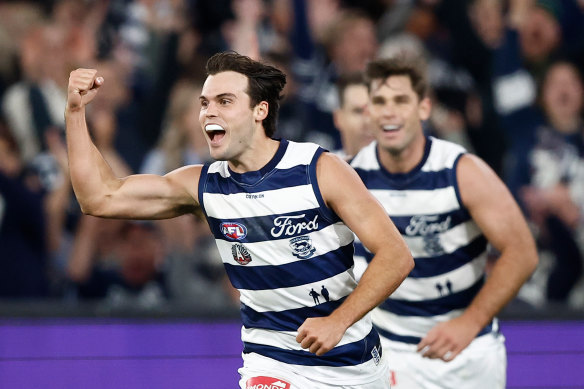By Marc McGowan
In the second of a two-part series on the direction of player movement in the AFL, we look at how Tasmania’s entry into the AFL could play out, as well as the potential next wave of changes, including pick purchasing.
This masthead spoke to 14 people across the AFL community, from various perspectives, on the condition of anonymity to enable them to discuss player movement matters more freely.

AFL chief Andrew Dillon launched the Tasmanian Devils in March this year.Credit: AFL Photos
Tasmania
Conversations are under way about what the incoming team’s draft concessions might be, and the suspicion is they will not be as generous as those afforded to Gold Coast or GWS. Clubs want to know by no later than mid-next year.
There is extra impatience given the league greenlighted the trading future picks two years in advance from the 2025 trade period. Two years from then is the 2027 draft, when the Devils are first set to be involved.
The AFL Players Association deliberately sought for the collective bargaining agreement to expire in 2027.

Priority selection Jeremy Cameron was an inaugural Giant.Credit: Louise Kennerley
The Giants had 11 of the first 14 picks in the 2011 draft ahead of their debut season, while Jeremy Cameron, Dylan Shiel and Adam Treloar were among 12 17-year-old priority selections they had access to, who were too young for the 2010 draft.
They were also able to recruit a capped number of uncontracted players from opposition clubs; players from outside the AFL who had previously nominated for a draft; and from particular zones, on top of having a bigger list.
Clubs expect Tasmania will have between six and eight first-round picks in 2027 – some of which must be traded for experienced players – plus at least the opening selection in each ensuing round. Like GWS, Tasmania’s concessions are set to extend beyond that first draft and for as many as three years.
Player agents were already inquiring at this year’s national under-15 schoolboys’ championships about which kids projected to be at the pointy end of the 2027 draft.
This year’s first-round draftees, who sign mandatory three-year deals as part of the new CBA, will come out of contract at the end of 2027, making them prime targets for Tasmania as well. Jagga Smith will be one of the first players picked in this month’s draft, and his father Michael grew up in Tasmania and was drafted by Collingwood as a 16-year-old, but did not play a game.
“There’s not much Tassie in me – I don’t get back there much, rarely ever, really,” Smith told this masthead. “There’s no drawback to Tassie or anything, but Dad obviously grew up there.”
Three first-round selections from last year’s draft, North Melbourne’s Colby McKercher, Western Bulldog Ryley Sanders and GWS’ James Leake, are Tasmanians. St Kilda’s Arie Schoenmaker, the No.62 pick, is also from Tasmania, as is Geordie Payne, whom the Kangaroos took at No.1 in this year’s mid-season draft.
One potential concept raised for the Tasmanian team was to bring kids who were 2027 draft-eligible into the state early and set them up with a private school scholarship, probably in Hobart.
Read part one of the series:
There is not enough time for them to be eligible for Tasmania’s academy, so the only scenario would be for the league to grant them access separately, such as in the Cameron, Shiel and Treloar example.
Another idea from clubland was for the league to increase list sizes by two, back to pre-COVID levels, in the lead-up to Tasmania’s entry, effectively serving as extra player development to help the new club, which will pick off a certain number of uncontracted footballers.
Club list bosses previously raised this with the league, but it is not expected to occur.
Free agents in 2027 could hit the jackpot, whether they stay or go – but there is no evidence yet that player managers will go out of their way to ensure their clients come out of contract after that season.
Club planning for Tasmania’s entry is set to begin in the next six months as they weigh up how they can utilise the new team’s concessions to help themselves, and contracting decisions for their players, including whether to offer longer deals for retention purposes.
Pick purchasing
Pick purchasing, where clubs would trade a draft selection in exchange for salary cap space, could come in within the next two trade periods – but there is a chance it won’t happen until after the CBA expires in 2027. This mechanism would take “salary dumping” to another level, given a player must be involved under current rules.
For example, Gold Coast dangled a top-10 pick two years ago as incentive for a club taking on Jack Bowes’ contract. After a frenzy of interest, Bowes picked Geelong, who scored pick seven after winning the 2022 premiership.
The benefit of pick purchasing for contenders is that they will be able to stave off a salary cap crunch for longer and keep their list together, while a rebuilding team with plenty of cap space can accelerate their ascent with more draft selections.
However, there is general wariness about the concept, and a desire for more rigour around the rules to avoid unintended consequences, or abuse of it, with the Tasmanian team’s arrival.

Jack Bowes was sent to Geelong along with pick seven.Credit: AFL Photos
Among the conversation points on pick purchasing during the competitive balance review process were whether the AFL would set a salary figure – similar to the draft value index – that equalled a certain draft pick return, or if there would be room for clubs to negotiate on a figure and selection. The latter is more likely.
Another talking point is whether the salary cap space being acquired would have to correlate with the year of the pick traded.
There is also no clarity on what, say, a top-10 selection would equate to in salary cap relief. The most common answer was north of $500,000 or even $600,000, but one list boss said the first team to do it might set the market.
Contract length
Free agency has enabled players and agents to strongarm clubs into six-plus-year deals, to retain top-tier talent and stave off suitors. The origin of this trend was Gold Coast and GWS giving their players monster contracts to match what Victorian clubs were proposing to bring them home.
It has gone to new levels since free agency came in 12 years ago, with most clubs having at least one player locked away into the 2030s. Part of the problem is that players have still enjoyed success requesting trades while contracted, including Dan Houston getting to Collingwood this year.
Some club people saw a positive in the trend, in that they had more salary cap flexibility to move money between seasons with long-term deals. However, the overriding feeling was something needed to be done for clubs to drag back some control.
Capping long-term deals at five years was an idea proposed by several club people, while another said an alternative would be to build more protection for clubs into player contracts to account for career-ending injuries or footballers barely playing for various reasons in certain seasons.
The AFLPA is unsupportive of any capping, while agents who spoke to this masthead said it was a restraint of trade and were emphatic it would never happen, just like their stance on trading players without consent – something else clubs want to be able to do.
Not even the potential lure of players reaching free agency after six rather than eight years as a trade-off was appealing enough.
Other key thoughts
- Abolishing the rookie list to have one list for all players appeals to clubs, who often use it to redraft their own delisted players. The AFL’s stance is that retaining the rookie list is about competitive balance. For example, a rebuilding team might have extra national draft picks, whereas a contender may have only three to use, meaning they must wait until the rookie list for anyone else they want to draft.
- List managers would like to transfer players from the primary to rookie list without having to delist and redraft them. Agents agree, assuming the player is happy to do so.
- There is a general push for list sizes to grow, but clubs fear it might go the other way. The league slashed two spots in the aftermath of COVID-19, but clubs remain interested in more players.
- Clubs have asked about trading national draft picks to improve their mid-season selection. The going rate would likely be a third- or fourth-round pick.
- There is interest in bringing back the veterans’ list for players who reach a certain age (possibly 32), which would enable clubs to pay them part of their salary outside the cap.
- Getting rid of the pre-season draft would lessen the threat of clubs losing a player for nothing if trade talks break down.
- Finding a way for clubs to draft more tall, project players is a priority for some, including the possibility of clubs having a dedicated spot for an extra 200-centimetre-plus prospect, much like a category B rookie.
Keep up to date with the best AFL coverage in the country. Sign up for the Real Footy newsletter.